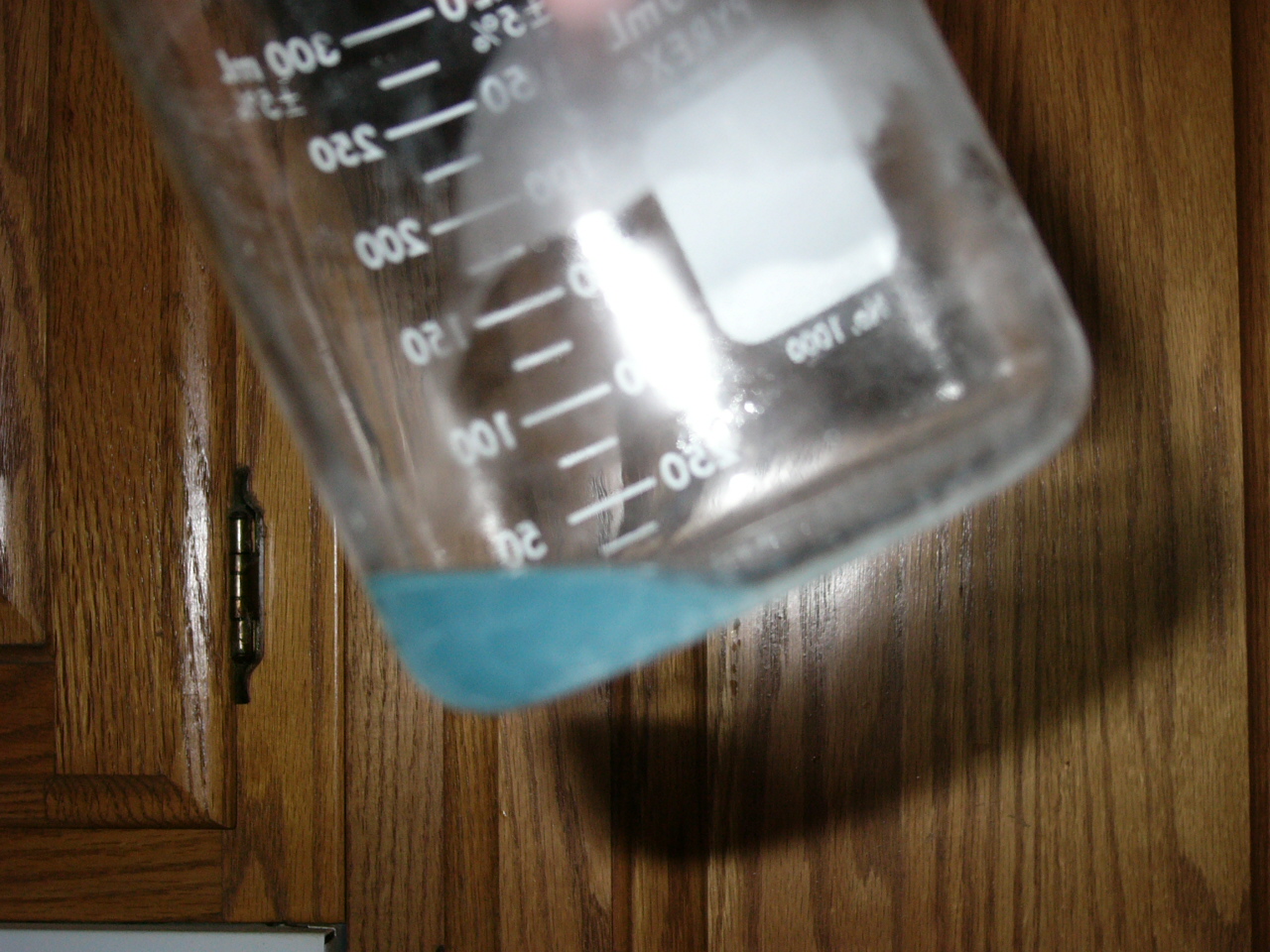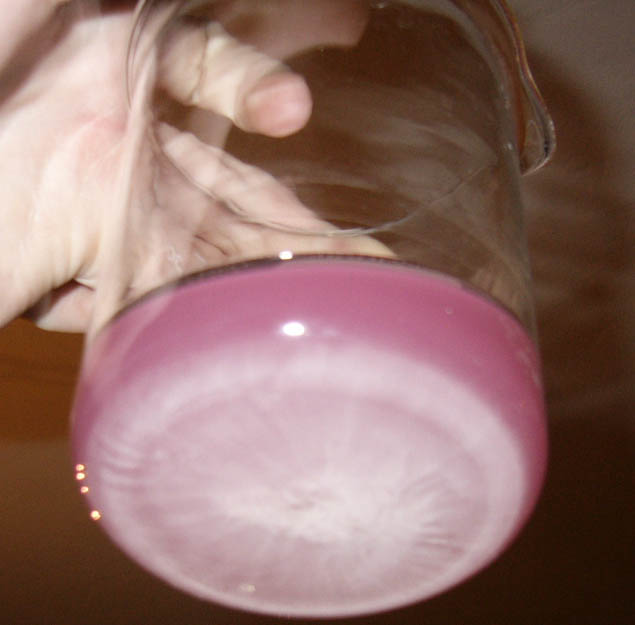| Pages:
1
2 |
budullewraagh
Hazard to Others
  
Posts: 168
Registered: 1-8-2004
Location: new york
Member Is Offline
Mood: Aliphatic
|
|
Blue? Potassium chlorate/perchlorate?
yesterday i decided to recover potassium chlorate/potassium perchlorate by adding match heads to boiling water, filtering out the recovered sulfur and
cardboard and boiling off the water. well, i found that as i concentrated it, the mixture (that ended up as a solution/suspension of white powder)
turned a certain light blue, as seen below. can anybody tell me what that blue is from?

|
|
|
The Ed
Harmless

Posts: 48
Registered: 22-6-2002
Member Is Offline
Mood: No Mood
|
|
Well... what color were the matchheads? If you're trying to get chlorate from matchheads you need to use a pretty fine filter, otherwise unwanted
crap is always gonna seep through. Is the blue a clearish blue or more opaque?
|
|
|
budullewraagh
Hazard to Others
  
Posts: 168
Registered: 1-8-2004
Location: new york
Member Is Offline
Mood: Aliphatic
|
|
the matchheads were white. click the link to see just how blue it is.
|
|
|
BromicAcid
International Hazard
    
Posts: 3245
Registered: 13-7-2003
Location: Wisconsin
Member Is Offline
Mood: Rock n' Roll
|
|
Remember that match heads contain significant quantites of ground glass to help the abrasiveness of them. You had a boiling mix of oxidizers,
anything come into contact with them that could have been oxidized, e.g., copper, nickel, stainless steel. These could have reacted and given you
your blue color.
|
|
|
budullewraagh
Hazard to Others
  
Posts: 168
Registered: 1-8-2004
Location: new york
Member Is Offline
Mood: Aliphatic
|
|
ah right. that's a bloody shame. i had been doing it in my beaker which was sitting in a pot, but that took too long so i just poured the
solution into the pot. still, i think the pot is stainless steel. i dont think iron has any ions that look blue, does it?
|
|
|
BromicAcid
International Hazard
    
Posts: 3245
Registered: 13-7-2003
Location: Wisconsin
Member Is Offline
Mood: Rock n' Roll
|
|
Stainless usually contains appreciable chromium and nickel which could have colored the reaction mixture, also I was thinking along the lines of a
copper bottomed pan but you didn't mention that.
Do some qualitative analysis on it, I would lay money on it being a metal cation. Copper and nickel of course spring first to mind.
|
|
|
The Ed
Harmless

Posts: 48
Registered: 22-6-2002
Member Is Offline
Mood: No Mood
|
|
Since there's a chance it's chromium or nickel compounds, be careful with that crap. Salts of those metals are fairly toxic.
|
|
|
Proteios
Hazard to Others
  
Posts: 109
Registered: 7-3-2004
Member Is Offline
Mood: No Mood
|
|
| Quote: | Originally posted by The Ed
Since there's a chance it's chromium or nickel compounds, be careful with that crap. Salts of those metals are fairly toxic.
|
Chuckle......
|
|
|
BromicAcid
International Hazard
    
Posts: 3245
Registered: 13-7-2003
Location: Wisconsin
Member Is Offline
Mood: Rock n' Roll
|
|
Chuckle? Although I don't treat nickel salts with as much respect as they deserve either, they do happen to be somewhat decent carcinogens.....
|
|
|
budullewraagh
Hazard to Others
  
Posts: 168
Registered: 1-8-2004
Location: new york
Member Is Offline
Mood: Aliphatic
|
|
lovely. now that you mention it, the bottom is copper and the blue i suppose is from aqueous nickel and chromium ions. that's a shame. next
time i do this i'll use less water to dissolve the match heads.
thanks for your help
[Edited on 3-9-2004 by budullewraagh]
|
|
|
budullewraagh
Hazard to Others
  
Posts: 168
Registered: 1-8-2004
Location: new york
Member Is Offline
Mood: Aliphatic
|
|
actually come to think of it...the iron should oxidize first. and there are no blue ions of chromium, iron or nickel
|
|
|
budullewraagh
Hazard to Others
  
Posts: 168
Registered: 1-8-2004
Location: new york
Member Is Offline
Mood: Aliphatic
|
|
i tried it again in a glass beaker and got the blue. it must be a dye in the match head that turns it white, but is blue.
|
|
|
hodges
National Hazard
   
Posts: 525
Registered: 17-12-2003
Location: Midwest
Member Is Offline
|
|
You can test for metal ions by adding a base such as NaOH to a solution and seeing if there is any precipitate. No precipitate would more likely
indicate an organic dye. Another test would be to add a strong acid and see if the color changes. Many organic dyes can act as indicators given
extreme pH levels.
|
|
|
budullewraagh
Hazard to Others
  
Posts: 168
Registered: 1-8-2004
Location: new york
Member Is Offline
Mood: Aliphatic
|
|
it's a dye
|
|
|
budullewraagh
Hazard to Others
  
Posts: 168
Registered: 1-8-2004
Location: new york
Member Is Offline
Mood: Aliphatic
|
|
i just did this again and used a few red match heads with the white ones, which, i just realized is not necessarily a good thing. the solution is now
red, so i don't believe the red is red phosphorus, but it could easily kill me if it is. do you think it is red p?
|
|
|
budullewraagh
Hazard to Others
  
Posts: 168
Registered: 1-8-2004
Location: new york
Member Is Offline
Mood: Aliphatic
|
|
and i came up with this...what is the white? sulfur or chlorate? (84 match heads in 100mL H2O strained with tissue paper twice)

|
|
|
BromicAcid
International Hazard
    
Posts: 3245
Registered: 13-7-2003
Location: Wisconsin
Member Is Offline
Mood: Rock n' Roll
|
|
The red color is a dye to my experience. The left over solid contains a high percentage of glass powder but is also chlorate/perchlorate. The sulfur
usually boils to the top like you mentioned before and is definitely yellow, mine came off rubbery like the rubberized sulfur from running 250C or
greater molten sulfur into cool water.
When I did this though I used about 3,000 match heads in a 2 liter pan. The whole bottom of the pan was covered with a paste of
chlorate/perchlorate/glass about 4 cm deep when the mixture was at full boil. Never analyzed the mixture though, at least you didn't try and
dissolve the match heads in HCl like I did 
(Red phosphorus is not incredibly toxic, well, unless you boil it in basified water.)
|
|
|
budullewraagh
Hazard to Others
  
Posts: 168
Registered: 1-8-2004
Location: new york
Member Is Offline
Mood: Aliphatic
|
|
i don't understand how you got that problem with HCl.
KClO3+HCl->ClO2??
anyway, you think i'm safe with distilling the brew i made?
|
|
|
BromicAcid
International Hazard
    
Posts: 3245
Registered: 13-7-2003
Location: Wisconsin
Member Is Offline
Mood: Rock n' Roll
|
|
Distilling? What kind of condensate are you hoping to collect, or do you just mean evaporating to dryness? If that is the case don't evaporate
totally to dryness, I made that mistake before as well.
You can go to my web page and look at both the HCl incident and evaporating to dryness, both of these fall into my mistakes category.
And yes, that is the equation for what happended and caused the explosion.
|
|
|
budullewraagh
Hazard to Others
  
Posts: 168
Registered: 1-8-2004
Location: new york
Member Is Offline
Mood: Aliphatic
|
|
yeah, i intend to boil off the water and end up with a bunch of white powder and a little solution in my beaker.
could you help me with the exact equation complete with charges?
|
|
|
budullewraagh
Hazard to Others
  
Posts: 168
Registered: 1-8-2004
Location: new york
Member Is Offline
Mood: Aliphatic
|
|
also, last i checked, potassium chlorate decomposed to yield O2, which isn't so bad. i had some of mine decompose a few days ago when doing the
same experiment, but it didn't blow up. perhaps when you did it you still had some sulfur?
|
|
|
STING
Harmless

Posts: 1
Registered: 8-9-2004
Member Is Offline
Mood: No Mood
|
|
potassium chlorate or perchlorate(blue??)
hi folks, to the ? of potassium chlorate or perchlorate---> he said he cut off the match heads"right" well what about the blue dye in the
paper stick, u know that is dark blue paper stick?? get my drift...
Edit: No need to create a new thread, I assume you did this by accident and confused the New Reply with the New Topic button....
[Edited on 8-9-2004 by chemoleo]
one thing in life is for sure and thats nothing is for sure
|
|
|
Quince
National Hazard
   
Posts: 773
Registered: 31-1-2005
Location: Vancouver, BC
Member Is Offline
Mood: No Mood
|
|
I'm having some trouble with the search function. Searching for chlorate gives too many results, and just about all are regarding either use of
chlorates, or synthesis using electrolysis. I'm trying to find NON-electrolytic synthesis procedures for either sodium or potassium chlorate.
BTW, I assume there's no problem if Half-Salt (sold as table salt that is half sodium/half potassium chloride) being used in electrolytic
synthesis?
\"One of the surest signs of Conrad\'s genius is that women dislike his books.\" --George Orwell
|
|
|
chloric1
International Hazard
    
Posts: 1142
Registered: 8-10-2003
Location: GroupVII of the periodic table
Member Is Online
Mood: Stoichiometrically Balanced
|
|
The electrolysis should be simple but..
Basically if you want chlorate you need at least 5 V and the 3 to 4 amps if you want a few grams the same day you started!
As far as Non-electrolytic synthesis goes, you could bubble chlorine gas through hot concentrated alkali and separate by fractional crystalization.
Chlorates are fairly cheap and you can even find them on ebay. I would not really bother with making them unless you want the learning experience.
Now Perchlorates are a little harder to get but I read an older J. Am Chem. article about repeated evaporation of potassium chlorate with 70% nitric
acid gives 30% yield. The rest is potassium nitrate so no need to waste anything.
[Edited on 2/4/2005 by chloric1]
[Edited on 2/4/2005 by chloric1]
Fellow molecular manipulator
|
|
|
FrankRizzo
Hazard to Others
  
Posts: 204
Registered: 9-2-2004
Member Is Offline
Mood: No Mood
|
|
I'm sure this has been mentioned before, but an old AT or ATX (with dummy load) computer power supply makes a nice source for 3.3/5/7/12V DC
current, and can usually be had for quite cheap.
Potassium chloride can be found in the hardware store as water softener salt for people worried about sodium affecting their health.
Carbon gauging rods are sold at the welding supply shop for ~$0.50, and make decent electrodes for this type of operation if the copper is stripped
off first.
|
|
|
| Pages:
1
2 |